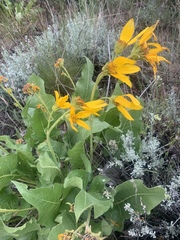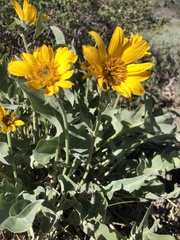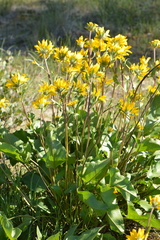The "arrow-leaved" balsamroots in Central Oregon
This is part of a series of Central Oregon plant ID notes; find the others here.
Summary
There are three species of balsamroot (Balsamorhiza spp.) with simple leaves and flat to notched leaf bases in or near Central Oregon. Carey's balsamroot (B. careyana) is most common in the east Cascades. It can be recognized by (usually) having stems with one large flower head and multiple smaller lateral heads, leaves that are hirsute (with short stiff straight hairs), and ray florets that persist on the seed after drying. Arrowleaf balsamroot (B. sagittata) is more common to the east in the lava plains and Ochoco Mountains. It is recognized by (usually) having a single flower head on each stem, densely tomentose (woolly with matted hairs) phyllaries (the bracts surrounding the flower head), and tomentose leaves, particularly on the undersides. Deltoid balsamroot (B. deltoidea) grows mainly west of the Cascade crest, but enters our area near the crest where it intergrades with Carey's balsamroot. It has stems with a single terminal flower head and maybe 1 or two smaller lateral heads, has leaves that are sparsely hirsute, and may have rounded teeth on the leaf margins. Balsamroots are notorious for hybridizing where species overlap, so it is often difficult to assign an individual plant to a species.
Introduction
Balsamroots (genus Balsamorhiza) are among our most showy wildflowers, with large basal leaves and tall stems with large yellow sunflower-like heads. There are 12 species of balsamroots in western North America, of which 3 have large arrow-shaped leaves (Balsamorhiza section Artorhiza) (FNA*), and all 3 of those species are found in or near Central Oregon (FoO/OFP*). The three species are Carey's balsamroot (B. careyana), arrowleaf balsamroot (B. sagitatta) and deltoid balsamroot (B. deltoidea). These species are sometimes difficult to tell apart, and may hybridize where their ranges overlap.
Species descriptions
See the Key Characteristics section for detailed distinguishing features.
Carey's balsamroot (B. careyana)
| Carey's balsamroot, from Observation 47946776 | Distribution on iNaturalist |
 |
Carey's balsamroot is recognizable by having green leaves with few short, coarse hairs and usually entire margins, usually having multiple flower heads on each stem, and having ray flowers that persist on the heads after drying. This species occurs mainly on the east slope of the Cascades and the Columbia Plateau from central Oregon to north-central Washington.
Arrowleaf balsamroot (B. sagittata)
| Arrowleaf balsamroot, from Observation 52336715 | Distribution on iNaturalist |
 |
Arrowleaf balsamroot is recognizable by having woolly grey leaves (sometimes only the lower surface of young leaves), usually single flower heads on each stem, and densely woolly phyllaries (bracts below the flower head). This species occurs throughout the intermountain region between the Cascades/Sierra Nevada and the Rocky Mountains from southern British Columbia south to California and Arizona.
Deltoid balsamroot (B. deltoidea)
| Deltoid balsamroot, from Observation 24287450 | Distribution on iNaturalist |
 |
Deltoid balsamroot is recognizable by having green leaves with few short, coarse hairs and wavy or toothed margins, one to several flower heads per stem, and ray flowers that fall as the head matures. The species primarily occurs west of the Cascades & Sierra Nevada from southern Vancouver Island to southern California. It approaches our area near the Cascade crest, in the Columbia River Gorge, and near the marshes of Klamath and Lake Counties.
Key characteristics
Based on consulting three recent floras: Flora of North America (FNA); Flora of the Pacific Northwest, 2nd ed. (FPNW2); Flora of Oregon, vol. 2 (FoO, OFP). Note that these floras disagree on some of the distinguishing characters, making this a very difficult group indeed.
Inflorescence
No. of heads per stem
- careyana — us. 3+, occ. 2 (FNA); several, ca. equal (FPNW2); 1 large, 1-6 smaller (FoO)
- sagittata — us. 1, occ. 2-3+ (FNA); 1, occ. 2-3 (FPNW2); 1 large, rarely 1-3 smaller (FoO)
- deltoidea — us. 1, occ. 2+ (FNA); several, lateral heads smaller (FPNW2); 1 large, 0-2 smaller (FoO)
Phyllaries (bracts below the heads)
- careyana — slightly or scarcely woolly (FPNW2); villous (with long, soft, unmatted hairs) to tomentose (with matted or tangled hairs)
- sagittata — generally woolly-tomentose (FPNW2); densely tomentose, esp. at base (FoO)
- deltoidea — slightly or scarcely woolly (FPNW2); villous, more densely at bases (FoO)
Ray Flowers: persistence
- careyana — "tardily deciduous, tending to persist on the achene and become +/- papery" (FPNW2); persistent after drying (FoO)
- sagittata — (no mention of deciduous vs persistent in any of the sources)
- deltoidea — early deciduous, not becoming papery (FPNW2); deciduous (FoO)
Leaves
Leaf margins
- careyana — entire, occ. crenate (wavy) to dentate (toothed) near base (FNA, FoO)
- sagittata — entire (FoO)
- deltoidea — crenate to dentate near base (FNA); entire to toothed, teeth rounded and apiculate (FoO)
Leaf surface
- careyana — green with few coarse hairs (FPNW2); with fine stiff hairs and gland-dotted (FNA); with fine stiff hairs (FoO)
- sagittata — silvery with feltlike wool when young, esp. lower surface (FPNW2); variously woolly (at least lower surface), sometimes nearly hairless, usually gland-dotted as well (FNA); surfaces woolly, more densely so on lower surface (FoO)
- deltoidea — green with few coarse hairs (FPNW2); usually with fine stiff hairs, sometimes not, usually gland-dotted (FNA); sparsely stiff-hairy on upper surface veins (FoO)
Sources
FNA: Flora of North America (online), http://beta.floranorthamerica.org
FoO: Meyers, SC, et al. (2015, 2020, 2022?) Flora of Oregon. BRIT press (3 vols. planned)
OFP: Oregon Flora Project, https://oregonflora.org, the online companion to FoO
FPNW2: Hitchcock, CL, and Cronquist, A (2018) Flora of the Pacific Northwest, 2nd edition. Univ. Washington Press





Comments
You could add Jepson's (CA) descriptions for deltoidea and sagittata. (They don't have careyana, obviously.)
https://ucjeps.berkeley.edu/eflora/eflora_display.php?tid=1634
https://ucjeps.berkeley.edu/eflora/eflora_display.php?tid=1643
Burke (WA) has less-technical descriptions for all three:
http://biology.burke.washington.edu/herbarium/imagecollection/taxon.php?Taxon=Balsamorhiza+careyana
http://biology.burke.washington.edu/herbarium/imagecollection/taxon.php?Taxon=Balsamorhiza+deltoidea
http://biology.burke.washington.edu/herbarium/imagecollection/taxon.php?Taxon=Balsamorhiza+sagittata
@adamschneider Thanks for the suggestions. For now, I'll leave the main article with just floras that cover Oregon, otherwise it might get too confusing. I expect that the Burke Museum (UW) treatment would be consistent with Flora of the Pacific Northwest, but it is a good resource for photos and less technical descriptions.
The compiling of the key characteristics is a valuable and time consuming undertaking. The similarity of the characteristics suggests that the understanding of PNW Artohiza requires features that are based on significant separation or unique features. To better understand the similarity and differences of this group in our area it would be of value to seek out Balsamorhiza and submit observations with images that detail the key features.
The one feature that appears to be one such character is the persistence of the ray-petals. Looking at iNaturalist observations there are some B. sagittata observations that suggest the character is present https://www.inaturalist.org/observation_fields/13086?value=persistent and https://www.inaturalist.org/observation_fields/13086?value=late+deciduous. This survey was just started and not complete. This is also dependent on the definition of character of the feature that defined B. careyana. Having looked at a number of B. deltoidea I recall that this taxa sheds it's ray petals early. I have not started the survey on B. deltoidea. The identified B. sagittata observations from Montana and British Columbia should cause one to question the value of ray-petal persistence as a key feature.
The other character of B. careyana is the multiple head count per stem. That is setup for a survey and may be reviewed at https://www.inaturalist.org/observation_fields/13100.
There are a number of addational characters that should also be recorded if the feature is subject to photographing. The observation field currently present for this is:
https://www.inaturalist.org/observation_fields/1931
https://www.inaturalist.org/observation_fields/13087
https://www.inaturalist.org/observation_fields/13088
https://www.inaturalist.org/observation_fields/13089
https://www.inaturalist.org/observation_fields/13085
@carexobnupta I hadn't realized that you had set up all those observation fields - it will be interesting to see an analysis after they get filled in. Looks like a lot of work to go through all the observations for these!
Re. persistence of ray flowers, as I noted in the article, that character is not mentioned for sagittata in any of the floras, so it seems only useful for distinguishing deltoides from careyana.
I am open to any suggestions of features that should be tracked. There are a number of features that may have value in identifying the taxa. I have not set up a observation field for all of the different features that are present. One of the distinctive characteristics is the leaf dentation of B. deltoidea. This feature is well developed in the Georgia and Puget Sound Basins but seems to diminish to the south becoming unapparent in the south Willamette Valley. However, this feature is apparent in the Dog Mountain Balsamorhiza.
I set up a collection project to sample "Artorhiza". This produces 2,600 observations in the northern range of the Artorhiza. The primary issue is the images span the growing season from spring emergence to summer drought. There are known changes in plant features over the growing season. Some of which may only last a week. Image quality and photographic detail further reduces identifiable characteristics. I suspect that with luck 10% of the images may contain identifiable features.
I would like to make an effort this year to sample addational Willamette Valley specimens and eastern Washington locations. The type location for B. deltoidea is some where in the Portland-Vancouver area and B. careyana is unknown but presumed to be between Lewistown and Walla Walla. The B. careyana Holotype specimen may be viewed at https://kiki.huh.harvard.edu/databases/specimen_search.php?mode=details&display.x=96&display.y=6&id%5B%5D=88490. The B. deltoidea type specimen is at https://kiki.huh.harvard.edu/databases/specimen_search.php?start=0&family=&gen=Balsamorhiza&sp=deltoidea&infra=&author=&year=&typestatus=&cltr=&collectornumber=&country=&yearcollected=&state=&county=&loc=&substrate=&habitat=&host=&provenance=&barcode=. The collection location is referred to as "Rocky Mountains"? This specimen has well developed crenate-dentate leaf margins.
@carexobnupta, would it make sense to prefix those fields with "Balsamorhiza: " so they're easier to find in the ridiculously long list of fields available in iNat? (Why don't they make it so that tags can be filtered by taxon??)
@adamschneider What you suggest is a valid consideration and I am thinking along that line. I also do not want to create new observation fields if there are existing fields that fit the need. I am also considering a traditional project "Artorhiza Taxa". iNat now requires 50 observations to make a traditional project and as soon as I have that number I can convert to a traditionally project from the collection project "Artorhiza".
With a traditional project a tool box for entering observations becomes available. This eliminates the issue of knowing the names of the observation fields. A tool box is designed within a project control panel and functions as a custom list of observation fields.
There is a way to filter by two independent variables, it is a little back door though. To set the filter up one needs to have an observation with the observation field of interest open, click on the field name and select "Observations with this field". In the new that opens, one can enter the taxa of interest for a narrowed double filtered search. At this time most of the observation fields listed above return just Balsamorhiza observations. See https://www.inaturalist.org/observations?verifiable=any&place_id=any&field:Artorhiza%20Leaf%20Outline.
I am open to structuring this in a way that works for everyone with an interest. I am also interested in suggestions of features that may be useful in sorting out these taxa.
Add a Comment